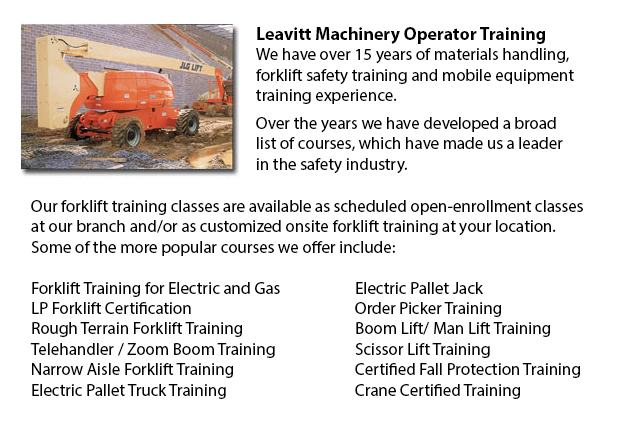
Barrie Aerial Platform Training - Aerial lifts can accommodate many duties involving high and tricky reaching places. Normally used to carry out regular upkeep in buildings with high ceilings, prune tree branches, hoist heavy shelving units or mend phone cables. A ladder could also be used for many of the aforementioned projects, although aerial lifts offer more safety and strength when correctly used.
There are many versions of aerial lift trucks available on the market depending on what the task required involves. Painters sometimes use scissor aerial jacks for example, which are classified as mobile scaffolding, effective in painting trim and reaching the 2nd story and above on buildings. The scissor aerial hoists use criss-cross braces to stretch out and lengthen upwards. There is a table attached to the top of the braces that rises simultaneously as the criss-cross braces lift.
Bucket trucks and cherry pickers are a different type of aerial hoist. They possess a bucket platform on top of an extended arm. As this arm unfolds, the attached platform rises. Lift trucks use a pronged arm that rises upwards as the handle is moved. Boom lifts have a hydraulic arm which extends outward and elevates the platform. All of these aerial lifts have need of special training to operate.
Training programs presented through Occupational Safety & Health Association, known also as OSHA, deal with safety methods, machine operation, upkeep and inspection and device cargo capacities. Successful completion of these training programs earns a special certified certificate. Only properly qualified individuals who have OSHA operating licenses should run aerial lift trucks. The Occupational Safety & Health Organization has developed rules to uphold safety and prevent injury when using aerial platform lifts. Common sense rules such as not utilizing this piece of equipment to give rides and making sure all tires on aerial lift trucks are braced in order to prevent machine tipping are noted within the guidelines.
Unfortunately, data expose that in excess of 20 aerial hoist operators die each year while operating and almost ten percent of those are commercial painters. The bulk of these accidents were triggered by improper tie bracing, hence several of these might have been prevented. Operators should make sure that all wheels are locked and braces as a critical security precaution to prevent the instrument from toppling over.
Other guidelines include marking the encircling area of the machine in an observable manner to safeguard passers-by and to ensure they do not come too close to the operating machine. It is imperative to ensure that there are also 10 feet of clearance amid any electrical cables and the aerial hoist. Operators of this equipment are also highly recommended to always wear the proper safety harness while up in the air.
-
Barrie Warehouse Forklift Safety Training
Barrie Warehouse Forklift Safety Training - Businesses normally face liability for injuries and damage sustained in workplace accidents. Warehouses can be hazardous places to the individuals who work there. That is the reason why employee safety is a... More -
Barrie Forklift Ticket
Barrie Forklift Ticket - Pallet jacks and lift trucks are both intended for practically the same reason; to transfer goods from one location of your warehouse to another. This is basically where the comparison stops however. With the pallet jack, the... More -
Barrie Aerial Lift Training
Barrie Aerial Lift Training - An aerial work platform is a mechanized access platform. This machinery provides access to otherwise not accessible places for people or equipment. Also referred to as an aerial device or elevating work platform, the mac... More -
Barrie Aerial Boom Lift Training
Barrie Aerial Boom Lift Training - For people who operate or supervise the use of aerial lift platforms, correct aerial boom lift Training is required. The aerial lift platform is utilized for lifting individuals, tools and materials to elevated work... More -
Barrie Manlift Certification
Barrie Manlift Certification - The Elevated Platforms and Manlifts Certification program helps to provide the needed training on the work practices, safe operating procedures, rules and regulations regarding the everyday activities for the operators... More -
Barrie Overhead Crane Certification
Barrie Overhead Crane Certification - The overhead crane training certification course is designed to be effective with all participants regardless of literacy or language limitations. The course has two parts: a classroom training session and a prac... More -
Wheel and Track Loader Training in Barrie
Lift trucks are obtainable in several various units that have varying load capacities. The majority of typical lift trucks utilized in warehouse settings have load capacities of one to five tons. Bigger scale models are used for heavier loads, such a... More -
Crane / Overhead Crane / Self-Erect Crane / Truck Mounted Crane / Hydraulic Cranes Training in Barrie
Overhead cranes are also referred to as bridge cranes. They are a type of crane which comprises a hook and line mechanism which runs along a horizontal beam that runs along two widely separated rails. A lot of overhead cranes can be seen in a long fa... More

Forklift Certification Barrie
TOLL FREE: 1-888-254-6157
Barrie, Ontario
forkliftcertificationbarrie.com
Email Us
About Us


